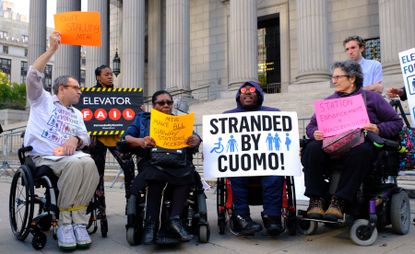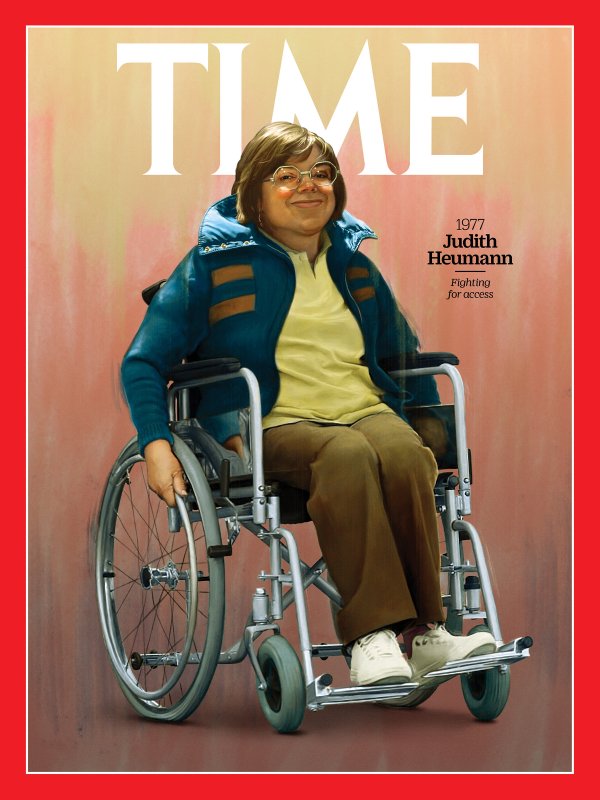We are a grassroots civil rights organization committed to ending discrimination against people with disabilities — all disabilities. We fight to eliminate the barriers that prevent us from enjoying full equality in American society. Founded in 1970, Disabled In Action (DIA) is a democratic, not-for-profit, tax-exempt, all-volunteer, membership organization without an office. DIA consists primarily of and is directed by people with disabilities. We believe in the motto, “Nothing about us without us!”

Our organizational structure:
Membership in DIA is open to all who share our goals. Members are entitled to vote, run for office, receive our literature, and join committees.
DIA is governed by a President, Legislative Vice President, Public Relations Vice President, Treasurer, Recording Secretary, Corresponding Secretary, and a Board of Directors. Officers and Board Members are elected by and accountable to the general membership.
A new DIA chapter can be formed by any group willing to abide by DIA’s principles. Approval by DIA of Metropolitan New York is legally required.
How do we accomplish our goals?
We educate government officials, community leaders, and administrators of established institutions as well as the general public. Among the methods employed are: obtaining radio, TV, press coverage, and video coverage of our activities and issues; testifying at in-person and video public hearings; participating in in-person and video public forums, conferences, and advisory committees to legislators, community groups, and governmental agencies. We also write letters, send emails and we have a FaceBook page. We work closely with other disability rights groups, too. If all else fails, we have a rally or demonstration complete with signs. If that does not work, we may do a lawsuit. Contrary to public opinion, lawsuits usually take years to resolve, so generally we try many other things first.
We work for the passage of laws that affirm and defend the rights of people with disabilities. The Americans with Disabilities Act (ADA) of 1990, the greatest achievement of the disability rights movement, guarantees equal access to employment, public services, public accommodations, transportation, and systems of communication. Major legislation supported by DIA prior to ADA includes: the U.S. Rehabilitation Act of 1973 (especially Section 504, the first Federal Civil Rights Law for disabled people); the Flynn Act that extended protection to disabled people under the NYS Human Rights Law; the Individuals with Disabilities Education Act (IDEA) requiring that every disabled child receive a free, appropriate education in the least restrictive environment; the State Polling Access Law of 1980 mandating that all polling places in NYS be accessible by 1990; Local Law 58, the 1987 NYC Building Code Amendment, authorizing that all commercial and residential buildings include accessible features in common areas and dwelling units when newly constructed or renovated.
We plan and participate in public demonstrations. To obtain passage of the Rehabilitation Act of 1973, DIA joined other organizations from all over the U.S. in Washington, DC. In 1974, DIA and other groups demonstrated in Albany for passage of the Flynn Act. DIA organized protests against the 1976 and 1977 United Cerebral Palsy (UCP) telethons and, later, the 1993 and 1994 Muscular Dystrophy Association “Jerry Lewis” telethons as demeaning and paternalistic “shows” celebrating and encouraging pity. In 1977, DIA participated in the nationwide sit-ins to obtain the signature of Health, Education and Welfare Secretary Califano on the Section 504 regulations. In the 80’s, DIA organized a sit-in at the Metropolitan Transportation Authority (MTA) and blocked traffic to demand wheelchair accessible city buses. Through the years, DIA has organized countless demonstrations at inaccessible polling sites, post offices, government offices, and places of business. We have protested federal, state, and city budget cuts to programs that are vital to members of our community. We have joined National ADAPT (as well as our local chapter, Downstate New York ADAPT) in nationwide and local actions to fight for personal assistance services and to defend the ADA.
We initiate and join lawsuits to enforce existing legislation. In 1976, DIA and twelve other disability organizations filed a federal class action lawsuit to force the federal government to develop Transbus, a ramp-bus design. DIA’s Section 504 lawsuit for lift-equipped city buses, along with Eastern Paralyzed Veteran’s Association (EPVA) NYS lawsuit for accessible subway stations, culminated in the NYS Governor’s Accessible Transportation Act of 1984. DIA participated, as an amicus curiae, in the Davis case that rejected a severely hearing-impaired woman’s admission to a registered nursing program (1978) and in the Baby Jane Doe lawsuit that denied equal access to health care to a disabled infant (1983). DIA’s polling site access state lawsuit begun in 1984 was settled in 1994. DIA filed the first ever ADA Title III (Public Accommodations) case in 1992 against the Helmsley-owned Empire State Building, as well as ADA lawsuits against: NYC for a public Town Hall meeting at an inaccessible site (1994); the federal government for noncompliance with Title II (public services) at 15 federal courthouses in NYC (1995); the NYC Human Rights Commission for failure to provide written material in alternate formats (1998); and the MTA for not operating Access-A-Ride in compliance with Title II of the ADA (1999).
We sued Duane Reade, the big drugstore chain, in 2001 for access to and within their stores. We settled and eventually, with much monitoring and discussion, all Duane Reade stores became fully accessible with sidewalk access and no separate locked accessible entrances, with clear aisles, and either one floor or an unblocked elevator to access throughout the stores.
We sued New York Waterways ferry company for access to their piers and boats in the early 2000’s. The culmination of the lawsuit resulted in a wonderful and accessible ferry ride around New York Harbor. Shortly after that, we got the Accessible Ferry Bill passed in 2005 by the New York City Council. It required all commuter ferries, ticketing areas, piers, and boarding areas in NYC to be accessible within a few years.
Our History
Disabled in Action was organized in 1970 by Judy Heumann, a young militant disabled woman, and other disabled activists at Long Island University, Brooklyn Campus. Ms. Heumann sued the New York City Board of Education when her application to obtain a teaching license was rejected because of her disability. Although the suit was settled out of court, the publicity it received served as the impetus for founding DIA.

DIA Facts
- In November 2023, DIA and other plaintiffs won the Edith Prentiss Disability Justice award for the subway access lawsuits.
- DIA received a Diversity, Equity, and Inclusion award in August 2023 from the AMNY publication. We consist of and represent the largest minority because we are disabled, we are diverse ages, we are diverse ethnic groups and races, and we work together for disability civil rights.
- DIA was the first website to publish a list of the Access-A-Ride Designated Pick-up and Drop-Off Locations. Yes, we had them listed before the MTA did!
- A former president of DIA, Frieda Zames, wrote a textbook in 2001 about the history and struggle for disability rights with her sister. The book was called “The Disability Rights Movement: From Charity to Confrontation” and it included DIA and New York City disability rights history.
- In 1992, immediately after the ADA went into effect, DIA sued the Empire State Building to make it accessible because there were steps to the famous observatory.
- DIA received the Frederick Douglass Award in 1986 from the North Star Fund “for outstanding contributions to the struggle for political, social and economic justice… and for work that exemplifies the tradition of fighting for the rights of all people in the spirit of Frederick Douglass.”
- The Disabled In Action Singers: Formed in 1982, they spread the DIA message of civil and human rights for all people with songs of peace, freedom and struggle.
- In the mid-1970’s DIA started protesting the lack of lifts on MTA buses in New York City in an effort to make the buses accessible. One demonstration happened when DIA members with disabilities blocked an M14 bus on Third Street at Avenue A during rush hour. It took about 20 years for the buses to all become accessible to people with mobility disabilities.
